
The Reserve Bank of India on Tuesday hiked its key short-term lending and borrowing rates by 25 basis points each with immediate effect to rein in inflation, a move that could increase banks' commercial lending rates.
Accordingly, the short term lending rate or (repo rate) stands at 6.25 per cent and the borrowing rate (reverse repo) at 5.25 per cent.
The RBI has, however, left the cash reserve ratio or bank rate, which is the amount of cash that banks have to park with the central bank to maintain prudential norms, unchanged at 6 per cent.
"These changes will be with immediate effect," the Reserve Bank said while announcing the second quarter monetary policy review in Mumbai on Tuesday.
. . .
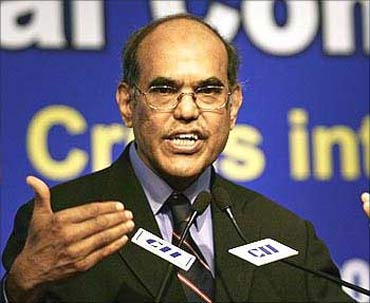
After announcing the latest round of rate hikes, which is the sixth since February this year, it said further rate action is relatively low in the immediate term, indicating that its consistent efforts at combating inflation has begun to bear fruits, even though this is still at a higher level.
So far, RBI has hiked the repo rate by 125 basis points one basis point is 0.01 per cent-- and the reverse repo by 175 bps, while it spiked the CRR by 100 basis points in two installments to tame inflation and to normalise the easy monetary and fiscal policies which were initiated by the RBI and government following the global financial crisis in September 2008.
. . .
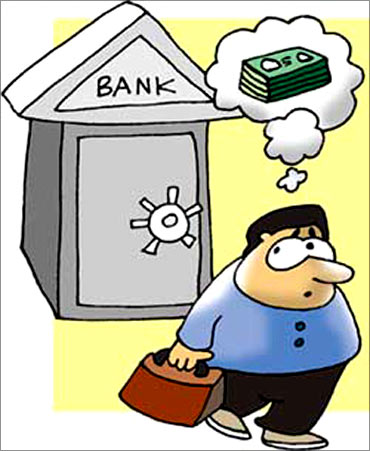
However, the central bank stressed that 'it does not want to disrupt growth.'
The bank 'aims to manage liquidity to ensure that it remains broadly in balance, with neither a surplus diluting monetary transmission nor a deficit choking off fund flows,' the bank said.
Since inflation turned on heat after turning negative for a few months towards the later part of 2009, battening it down has been the key concern of the apex bank.
And these rate hikes are aimed at taming inflation, especially food prices, which the RBI feels has assumed some structural character.
On Monday in its macroeconomic and monetary developments, second quarter review of FY11, the apex bank maintained that inflation is at a 'disconcertingly high level' and that the rising capital inflows and the resultant appreciation of the rupee are posing challenges to its efforts at managing the macroeconomic fundamentals without hurting economic growth which of late has been losing steam.
. . .

It can be noted that the factory production numbers for August nosedived to a poor 5.6 per cent to hit a 15-month low, while the September core sector figures too hit an 18- month pit to a paltry 2.5 per cent.
On the continued rise in capital flows into the country, which has so far crossed $25 billion this year, RBI said it will intervene in the forex markets if these inflows turn volatile and lumpy.
On the rupee front, RBI noted that since September, the currency has risen by almost 6 per cent against the US dollar, while it was declining against other major international currencies like the euro, pound and the yen.
On the new bank licences, the apex bank said that the guidelines would be ready by end January 2011.
Expressing its concern over some banks still continuing to offer teaser home loans -- loans which are offered at lower than the market rates to woo new customers -- the apex bank said, those commercial banks will have to make an additional 2 per cent provisioning for such advances.
The banking regulator also said that it would be issuing draft guidelines on savings rate deregulation by the end of December.
. . .

The hike in these key rates is expected to:
i. Sustain the anti-inflationary thrust of recent monetary actions and outcomes in the face of persistent inflation risks.
ii. Rein in rising inflationary expectations, which may be aggravated by the structural nature of food price increases.
iii.Be moderate enough not to disrupt growth.
The Reserve Bank said that it will continue to closely monitor both global and domestic macroeconomic conditions.
"We will take action as warranted with a view to mitigating any potentially disruptive effects of lumpy and volatile capital flows and sharp movements in domestic liquidity conditions, consistent with the broad objectives of price and output stability," the bank said.
Based purely on current growth and inflation trends, the Reserve Bank believes that the likelihood of further rate actions in the immediate future is relatively low.
"However, in an uncertain world, we need to be prepared to respond appropriately to shocks that may emanate from either the global or domestic environment," the RBI added.
The next mid-quarter review of Monetary Policy for 2010-11 will be announced through a press release on December 16, 2010.
. . .

Impact on household expenses and borrowers
Banks might increase the base rate considering the fact that credit demand will pick up and bankers will assess the demand supply situation before taking a call.
The repo rate has been increased under the liquidity adjustment facility by 25 basis points from 6.0 per cent to 6.25 per cent with immediate effect, and the reverse repo rate has been hiked under LAF by 25 basis points from 5.0 per cent to 5.25 per cent with immediate effect.
All these factors will lead to an increase in the base rate of the banks. This in turn will lead to an increase in your housing loan, car loan and personal loan rates.
The increase in the repo rate and reverse rate will be good news for depositors as banks will hike the deposit rates before they take a call on the lending rates linked to base rate.
Both lending and deposit rates are likely to go up, although by how much cannot immediately be said.
The increase in interest rates, however, will depend on whether banks would want to absorb the CRR hike, until credit off-take increases meaningfully, before hiking lending rates.
. . .
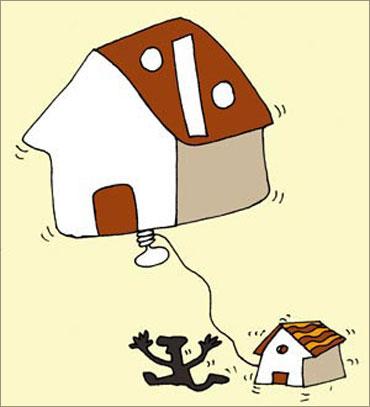
Floating rate home loans
Floating rate home loan borrowers may have to brace up for another round of hike in their interest commitments, although not in the immediate future. In the long term, the CRR hike could lead to a general rise in interest rates in the economy, at times leading to resetting of equated monthly installments on flexible home and personal loans.Effect on EMIs
In the long term, repayments may increase by over Rs 350,000-400,000 over a 20-year period on a Rs 20-lakh (Rs 2-million) home loan, if the country's banks hike interest rates by up to 1 per cent following the tight monetary measures announced by RBI.
Consumers may have to fork out up to Rs 1,500 more every month for a home loan of Rs 20 lakh, as experts say that interest rates could go up by 0.75-1 per cent after RBI's hawkish policy aimed at containing inflation.
Personal loans
The interest rates on personal loans too are likely to rise, for it is expected that banks will pass on the burden to the consumers.
Car loans
With RBI hiking rates, your dream car may have become more expensive. Car loan lenders have jacked up interest rates on loans by anything between 75 to 100 basis points, and as a double whammy to you, even car manufacturers are increasing prices due to heavy input costs.
. . .

What should one expect on the rate front going forward?
RBI has always been proactive and has worked towards tackling issues in a timely manner -- this time it being inflation.
The inflationary pressure is going to exist for some time going forward which means rate hike will be the name of the game (provided the economy doesn't take a turn for the worse).The interest rate cycle has turned and here on rates can only increase.
What should new buyers do?
This could be the best time to take a home loan or auto loan because rates will eventually rise. Fixed rate product may not be a bad idea at all.
Why RBI was forced to hike rates?
While recovery in advanced economies has slowed in the second half of 2010, emerging market economies continue to show strong growth.
The fragile and uneven nature of the recovery and large unemployment in advanced economies raise concerns about the sustainability of the global recovery, which has prompted the International Monetary Fund to project a lower world GDP growth of 4.2 per cent in 2011 as compared with 4.8 per cent in 2010.
. . .

The rising concerns about the slowing momentum of recovery have prompted the central banks of some advanced economies to initiate (or consider initiating) a second round of quantitative easing to further stimulate private demand.
While the ultra loose monetary policy of advanced economies may benefit the global economy in the medium-term, in the short-term it will trigger further capital inflows into emerging market economies and put upward pressure on global commodity prices.
On the domestic front, economic activity is firmly in place. The 8.8 per cent GDP growth for Q1 of 2010-11 suggests that the economy is operating close to the trend growth rate, driven mainly by domestic factors.
The South-West monsoon was normal which should boost agricultural output and rural demand. Most industrial and service sector indicators also point towards sustained growth.
Notwithstanding some moderation in recent months, headline inflation remains significantly above its medium-term trend.
What is of concern is that while non-food manufactured products inflation has stabilised, food inflation has not shown the expected post-monsoon moderation.
. . .

Persistently rising food prices even in the wake of a normal monsoon raise concerns about the structural nature of food inflation and its consequent impact on inflationary expectations.
Further, when the economy is growing close to trend, the risks of structural food inflation spilling over into prices of other commodities are significant and that could potentially offset the recent moderation.
Industrial growth has been robust, although apparently with a significant increase in volatility.
The year-on-year increase in the index of industrial production varied in a range of 5.6 to 15.2 per cent during April-August 2010, with an average of 10.6 per cent. Industrial growth was high in the capital goods, consumer durables and intermediate goods sectors.
While the volatility raises concerns about a deceleration, other indicators of economic activity suggest continuing momentum.
Exports have grown steadily during the first half of 2010-11, showing an increase of 27.6 per cent over the corresponding period of last year.
Based on an analysis of a sample of 2,546 non-financial companies, private corporate sector sales rose by 24 per cent year-on-year in Q1 of 2010-11.
. . .
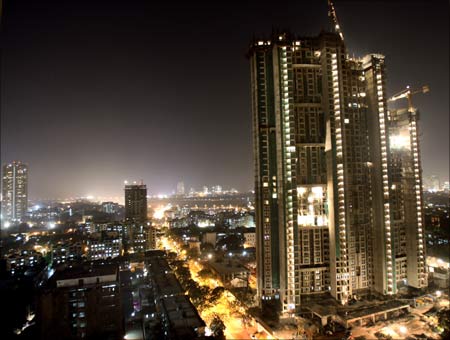
Early results of corporate performance indicate sustained sales growth and improved profitability in Q2 of 2010-11.
Direct tax collections, as reflected in advance taxes paid in September 2010, rose by 16.5 per cent over last year.
Similarly, indirect tax collections during the April-September period were 43.1 per cent higher than in the corresponding period of 2009.
The buoyancy in various service sectors witnessed in the second half of 2009-10, has continued this year as well.
The latest quarterly industrial outlook survey conducted by the Reserve Bank indicates improvement in the overall business conditions. Other business conditions surveys also indicate a similar trend.
While the Reserve Bank's survey on capacity utilisation indicates that there is a small decline in utilisation at the aggregate level, several sectors appear to be facing capacity constraints, resulting in increased imports.
On the inflation front, the new series of wholesale price index released on September 14, 2010 is a better representative of commodity price levels with an updated base (2004-05=100) and wider coverage of commodities.
. . .
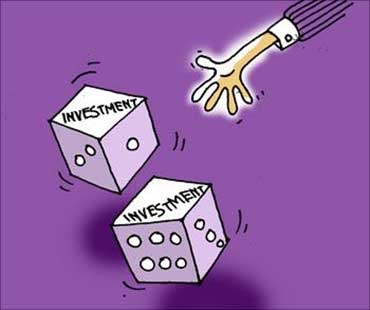
While inflation at the aggregate level does not show much variation over the medium-term between the old and new series, there are significant differences in inflation at the disaggregated level.
As per the new WPI series, the year-on-year inflation moderated to 8.5 per cent in August 2010 and 8.6 per cent in September 2010 after remaining in double digits during March-July 2010.
At a disaggregated level, inflation in primary articles, especially food articles, in the new series has been significantly higher than in the old series, whereas for manufactured products, it has been somewhat lower.
During 2010-11, although the year-on-year primary food inflation moderated from 21.4 per cent in May 2010 to 15.7 per cent in September 2010, the moderation was not commensurate with patterns following a normal monsoon on previous occasions.
This is partly a reflection of the growing importance of protein-rich items in the consumption basket for which price increases have been large.
The year-on-year inflation rate in protein-based food items such as pulses, milk, eggs, fish and meat (with a combined weight of 6.4 per cent in WPI basket), peaked at 34 per cent in May 2010 and remained very high at 23.9 per cent in September 2010.
. . .
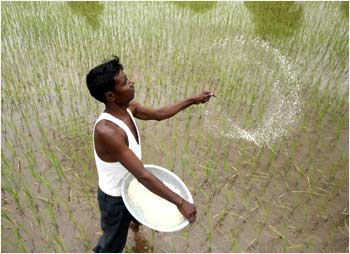
Inflation in the other primary food articles (weight: 8.0 per cent) moderated from 14.0 per cent in June 2010 to 9.4 per cent in September 2010, more visibly reflecting the impact of normal monsoon on prices of major cereals, fruits and vegetables.
In sum, despite some moderation, overall food price inflation remains at an elevated level.
The year-on-year inflation as of September 2010 was also high for certain primary non-food articles such as raw rubber (57.4 per cent), sugarcane (53.3 per cent) and cotton (27.5 per cent). The rise in cotton prices reflected global trends.
Focusing on the manufacturing sector, the year-on-year WPI non-food manufactured products (weight: 55.0 per cent) inflation increased from (-) 2.0 per cent in September 2009 to a peak of 5.9 per cent in April 2010, before moderating to 5.0 per cent in September 2010.
Non-food items inflation (WPI excluding food products and food articles), which was (-) 2.9 per cent in September 2009, rose sharply to 9.2 per cent in April 2010 before moderating to 7.8 per cent by September 2010.
Non-food items (weight: 75.7 per cent) contributed 65.5 per cent to WPI inflation in September 2010, up from 40.5 per cent in January 2010.
. . .

Inflation based on CPI for industrial workers has moderated to single digit since August 2010 after remaining in double digits for 13 months.
However, the various CPI baskets still reflect the consumption pattern of the mid-1980s and 2001 which have a relatively higher weight for cereals, whereas more updated (2004-05) WPI basket suggests that food consumption has shifted towards protein-rich items where price increase has been high.
To that extent, CPI baskets understate the underlying food inflation.
Money supply growth moderated from 16.8 per cent on a year-on-year basis at end-March 2010 to 14.5 per cent at end-May 2010 before increasing to 15.2 per cent by October 8, 2010. At this level, it was below the indicative projection of 17.0 per cent for 2010-11.
The lower M3 growth essentially reflected the moderation in growth in bank deposits, particularly long-term deposits. Furthermore, currency growth has been higher than deposits growth which reduced the money multiplier, thereby lowering M3 growth.
. . .

A contributory factor to this trend has been negative real interest rates on deposits, which have induced depositors to both hold currency and invest in non-financial assets, including gold and real estate, whose prices have shown significant increases over the course of the current year.
Non-food credit growth accelerated from 17.1 per cent on a year-on-year basis at end-March 2010 to 22.3 per cent by July 2, 2010, reflecting in part the higher credit demand emanating from telecom spectrum auctions.
Although it moderated to 20.1 per cent as of October 8, 2010, it was in line with the indicative trajectory of 20 per cent for 2010-11 set out in the Monetary Policy Statement of April 2010. Even after adjusting for spectrum auction related advances, growth in bank credit during the current financial year so far has been in line with the long-term trend.
Disaggregated data suggest that year-on-year credit growth to large industries, including infrastructure (especially power and telecom), and housing sectors improved significantly.
The increase in bank credit to the commercial sector was also supplemented by the higher flow of funds from other sources.
Rough estimates showed that the total flow of financial resources from banks, non-banks and external sources to the commercial sector during the first half of 2010-11 was higher at Rs 485,000 crore (Rs 4,850 billion), up from Rs 329,000 crore (Rs 3,290 billion) during the same period of previous year.